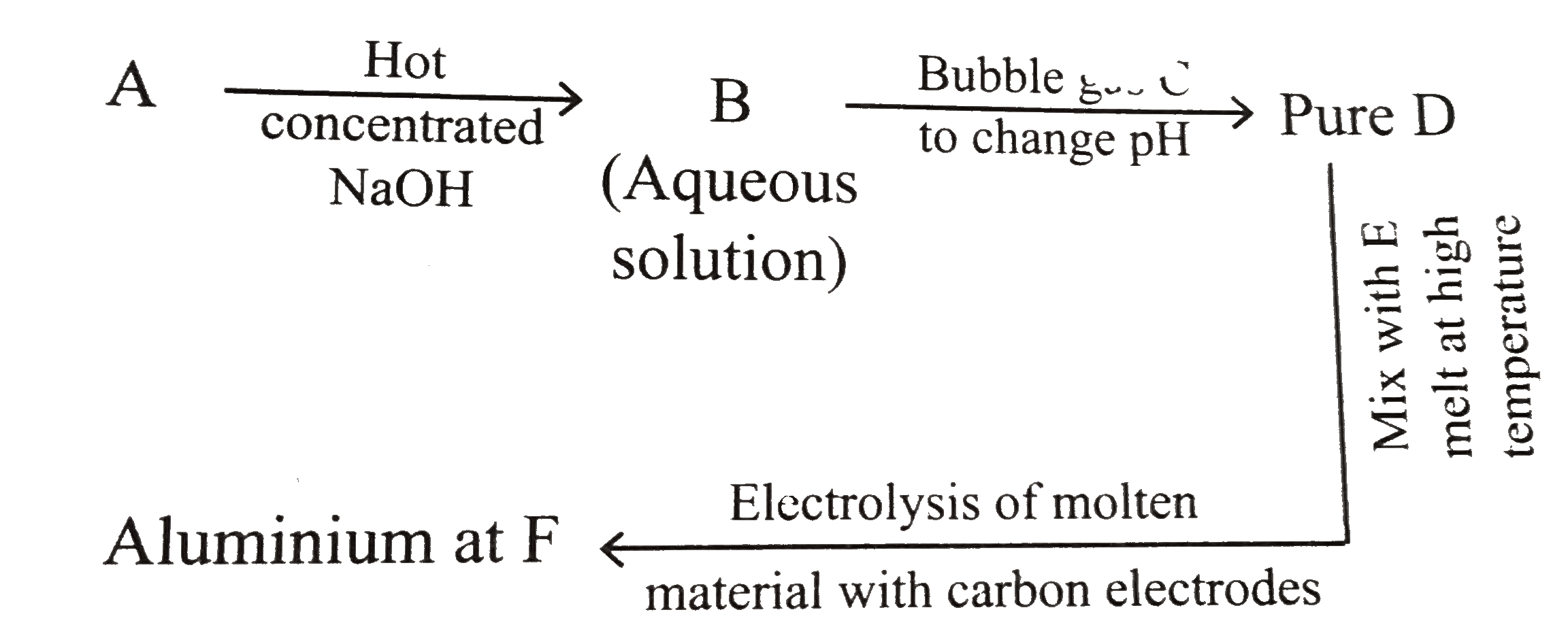
F is.
A
Cathode
B
Anode
C
Electrolyte
D
None of these
Video Solution
Text Solution
The correct Answer is:A
Al2O3.2H2O(A)+2NaOH+H2O→2Na[Al(OH)4]Sodium aluminate (B)
2Na[Al(OH)4]+2CO2(C)→Al2O3Pure.2H2O+2NaHCO3+H2O
Al2.O3.2H2O is mixed with cryolite, Na3AlF6(E) to reduce the melting point of the mixture and increases conductivity. On electrolysis. Al is deposited at cathode (F)
At cathode : At3++3eӨ→Al
Al anode : C+O2−→CP+2eӨ
C+2O2−→CO2+4eӨ.
Hence,
F is cathode.
|
Updated on:21/07/2023
Topper's Solved these Questions
- BOOK - CENGAGE CHEMISTRYCHAPTER - GENERAL PRINCIPLES AND PROCESS OF ISOLATION OF ELEMENTSEXERCISE - Exercise (Multiple Correct)43videos
GENERAL PRINCIPLES AND PROCESS OF ISOLATION OF ELEMENTS
- BOOK - CENGAGE CHEMISTRYCHAPTER - GENERAL PRINCIPLES AND PROCESS OF ISOLATION OF ELEMENTSEXERCISE - Exercise (Single Correcttype)106videos
GENERAL PRINCIPLES AND PROCESS OF ISOLATION OF ELEMENTS
- BOOK - CENGAGE CHEMISTRYCHAPTER - GENERAL PRINCIPLES AND PROCESS OF ISOLATION OF ELEMENTSEXERCISE - Exs 1.1 (True Orfalse Statement)19videos
GENERAL PRINCIPLES AND PROCESS OF ISOLATION OF ELEMENTS
- BOOK - CENGAGE CHEMISTRYCHAPTER - ELECTROCHEMISTRYEXERCISE - Archieves Subjective35videos
ELECTROCHEMISTRY
- BOOK - CENGAGE CHEMISTRYCHAPTER - GRIGNARD REAGENTS AND ORGANOMETALLIC REAGENTSEXERCISE - Exercises Archives (Linked Comprehension)1videos
GRIGNARD REAGENTS AND ORGANOMETALLIC REAGENTS
Similar Questions
Knowledge Check
- Question 1 - Select One
If f (x) is a polynomial satisfying f(x) f (1/ x) = f (x) + f (1/x) and f (3) = 28, then f (2) is given by
A63B65C67DNone of these - Question 2 - Select One
Let f:R→R is not identically zero, differentiable function and satisfy the equals f(xy)=f(x)f(y)andf(x+z)=f(x)+f(z), then f(5)=
A3B5C10D15 - Question 3 - Select One
If f (x) is polynomial of degree two and f(0) =4 f'(0) =3,f''(0) =4,then f(-1) =
A2B-2C3D-3
If f (x) is a polynomial of degree two and f(0) =4 f'(0) =3,f'' (0) 4 then f(-1) =
View SolutionIf f(x)=2x+1 then the value of x satisfying the equation f(x)+f(f(x))+f(f(f(x)))+f(f(f(f(x)))=116 is equal to
View SolutionIf f(1)=1,f'(1)=3, then the derivative of f(f(f(x)))+(f(x))2 at x = 1 is
View SolutionIf the function f:N→N is defined by f(x)=√x, then f(25)f(16)+f(1) is equal to
View SolutionIf f(−x)=−f(x) , then f(x) is
View Solution

